不定式用法归纳全
不定式知识点归纳总结
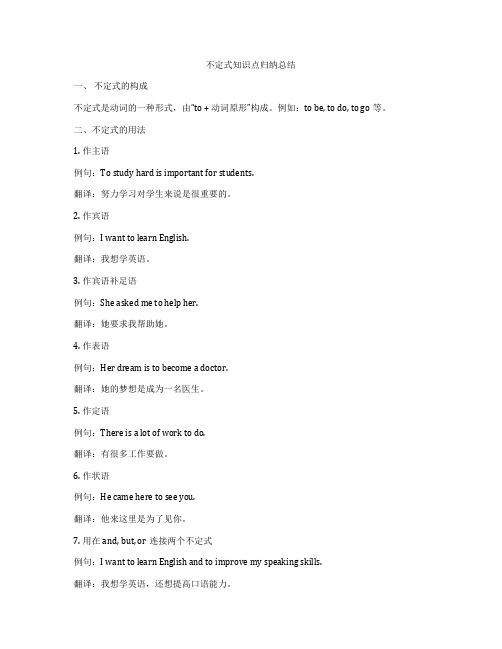
不定式知识点归纳总结一、不定式的构成不定式是动词的一种形式,由“to + 动词原形”构成。
例如:to be, to do, to go等。
二、不定式的用法1. 作主语例句:To study hard is important for students.翻译:努力学习对学生来说是很重要的。
2. 作宾语例句:I want to learn English.翻译:我想学英语。
3. 作宾语补足语例句:She asked me to help her.翻译:她要求我帮助她。
4. 作表语例句:Her dream is to become a doctor.翻译:她的梦想是成为一名医生。
5. 作定语例句:There is a lot of work to do.翻译:有很多工作要做。
6. 作状语例句:He came here to see you.翻译:他来这里是为了见你。
7. 用在and, but, or连接两个不定式例句:I want to learn English and to improve my speaking skills.翻译:我想学英语,还想提高口语能力。
8. 与形容词和副词连用例句:I'm happy to meet you.翻译:见到你我很高兴。
9. 用在名词前表示目的,结果等例句:He gave us some advice to help us study better. 翻译:他给了我们一些建议,帮助我们更好地学习。
三、不定式的特殊用法1. with + 宾语 + 不定式例句:He left me with nothing to say.翻译:他让我无话可说。
2. for + 宾语 + to 不定式例句:We have a lot of work for you to do.翻译:我们有很多工作需要你做。
3. 不定式的被动形式例句:The book is difficult to finish.翻译:这本书难以完成。
初中英语知识点归纳不定式的用法

初中英语知识点归纳不定式的用法不定式是英语中的一种动词形式,由"to"加上动词原形构成。
在句子中,不定式可以作为动词、名词或形容词的补语,具有多种用法。
本文将归纳初中英语中不定式的用法。
一、不定式作动词的宾语不定式可以作为动词的宾语,表示动作或状态的延续。
例如:1. I want to go shopping.(我想去购物。
)2. She likes to sing.(她喜欢唱歌。
)3. They plan to visit Beijing.(他们计划去北京旅游。
)二、不定式作主语不定式可以作为句子的主语,通常用于表示抽象概念或一般情况。
例如:1. To learn a foreign language is important.(学习一门外语很重要。
)2. To eat healthily is good for us.(健康饮食对我们有益。
)3. To be honest is necessary.(诚实是必要的。
)三、不定式作目的状语(表示目的或原因)不定式可以表示某种动作或状态的目标或目的。
例如:1. I bought a new dictionary to improve my English.(我买了一本新字典来提高我的英语水平。
)2. We need to work hard in order to achieve our goals.(我们需要努力工作以实现我们的目标。
)3. He goes to the gym every day to keep fit.(他每天去健身房保持健康。
)四、不定式作结果状语(表示结果)不定式可以表示某种动作或状态的结果。
例如:1. The weather was so bad as to cancel the flight.(天气太糟糕导致航班取消。
)2. He was too tired to continue working.(他太累了不能继续工作。
不定式知识点归纳总结

不定式知识点归纳总结不定式是英语中的一种非谓语动词形式,在句中可以作为名词、形容词或副词使用,具有无人称、无时态和无语态的特点。
在语法上,不定式是一个复合结构,由to + 动词原形构成。
本文旨在归纳总结不定式的用法和相关知识点。
一、作名词用的不定式1. 作主语不定式可作主语,常用结构为:To + 动词原形。
例如:To learn a foreign language is challenging.(学习外语很有挑战性。
)2. 作宾语不定式可作及物动词的宾语,常用结构为:动词 + 不定式。
例如:She wants to visit her grandparents.(她想去看望她的祖父母。
)3. 作介词的宾语不定式可作介词的宾语,常见的介词有:to, for, about, of, in, on等。
例如:I am looking forward to meeting you.(我期待着见到你。
)4. 作表语不定式可作表语,常用结构为:主语 + be动词 + 不定式。
例如:Her dream is to become a doctor.(她的梦想是成为一名医生。
)二、作形容词用的不定式1. 修饰名词不定式可用来修饰名词,常见结构为:a(n) + 形容词 + 不定式。
例如:He has a lot of work to do.(他有很多工作要做。
)2. 修饰不定代词不定式可用来修饰不定代词,常见的不定代词有:something, nothing, everything, someone, anyone, no one等。
例如:There is nothing to worry about.(没有什么可担心的。
)三、作副词用的不定式1. 修饰动词不定式可以修饰动词,表示动作发生的目的、结果等。
常见结构为:动词 + 不定式。
例如:He went to the store to buy some groceries.(他去商店买了些食品杂货。
动词不定式的用法总结

动词不定式的用法总结动词不定式(to do)是英语课的一个重点,也是很多考试中要考查的一个项目。
你知道动词不定式的用法有哪些吗?接下来,小编给大家准备了动词不定式的用法总结,欢迎大家参考与借鉴。
●动词不定式的用法总结动词不定式属于非谓语动词的一种形式,很多同学经常把它和谓语动词混在一起,掌握起来有困难。
下面我们对动词不定式的用法做简单归纳,帮助同学们记忆:一、动词不定式在句子中不能充当谓语,没有人称和数的变化。
二、动词不定式是由“to+动词原形”构成(有时可以不带to)。
动词不定式的否定形式是“not+动词不定式”(not不与助动词连用)。
三、动词不定式短语具有名词、形容词和副词等的功能,可在句中用做多种句子成分。
1、主语:常置于句末,而用it代替其做形式主语。
例:To go in for sports helps youstay fit.(book4,L28)It helps you stay fit to go in for sports. It is dangerous to swim in the deep sea on your own.注:此句式中不定式逻辑上的主语可由for或of引出,逻辑主语由of引出时,表语的形容词为kind,nice,good,polite,clever,foolish,right,wrong等表示评价的形容词。
例:It's right of him to refuse the invitation1.(him为逻辑主语)2、表语:Our duty is to protect the enviroment.3、动词宾语:此种情况可按固定搭配或句式去记。
例:would you like to see my photos?Kevin planned to visit his uncle.(book4,L11)和plan用法一样的词还有:start,want,agree,hope,begin,decide等。
史上最完整动词不定式的用法

4.动词不定式作表语
1.主语和表语都是不定式(其含义ind to the enemy is to be cruel to the people.
To do that would be to cut the foot to fit the shoe.
2 . 主 语 是 以 aim, duty, hope, idea, intention, mistake, plan, proposal, job, suggestion 等为中心词的名词词组,或以 what 引导的名词性从句表示,表语用不定 式说明其内容,如:
1. 动词不定式作主语 动词不定式作主语,谓语动词用第三
人称单数。
To get there by car will take a whole day.
How to get enough money is still a question.
1. 动词不定式作主语
有时候为了保持句子平衡,常用it 作形式主语,放到句首,而将作真 实主语的动词不定式放到句末。
My idea is to climb the mountain from the north. My suggestion is to start work at once.
What I would suggest is to start work at once.
注:在某些句型中,当主语部分有动作 动词do 时,作表语的不定式可以省略符 号 “to”,如:
3. We climbed to the top of the tower ___D_____a better view of the area.
A. getting
B. got
C. having got
动词不定式的基本用法归纳经典实用

•动词不定式的基本用法归纳
此课件下载可自行编辑修改,供参考! 感谢你的支持,我们会努力做得更好!
All I want to do now (What I want to do now) is fill
my stomach.
•动词不定式的基本用法归纳
4.作宾语补足语
【注意】在感官动词(see, hear, feel, listen to , notice, watch, observe等)和使役动词(let, have, make )后的补足语中,不定式不带to。但这类 句子变成被动语态时,必须带to。
有时置于句中或句未,须状语常用如下句型
Too + 形容词/副词 + to do sth 名词/ 形容词/副词 + enough + to do sth enough+名词 +to do sth such +(形容词)名词 +as to do sth so + 形容词/副词 + as to do sth 【注意】不定式作状语,其逻辑主语与句子的
5.定语
1、不定式与被修饰的名词往往构成逻辑上的关系。 如名词为不定式的逻辑主语,构成主谓关系; 若名 词为逻辑宾语,则构成动宾关系;
He is not a man to tell lies.
There will not be enough space to stand in on the earth 2、作定语的不定式与所修饰的名词之间是动宾关系, 不定式动词又是不及物动词时,应在该动词上加上 一个介词,如;
(2)To master English gives us much help in the study of sience. B. 不定式或不定式短语作主语时,常用it作形 式主语,构成“It is + 形容词(+for sb.)不定式” 结构。
不定式的用法和常见结构详解
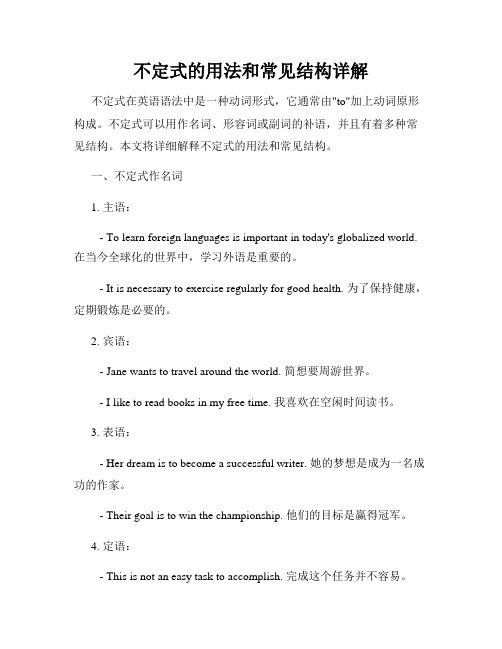
不定式的用法和常见结构详解不定式在英语语法中是一种动词形式,它通常由"to"加上动词原形构成。
不定式可以用作名词、形容词或副词的补语,并且有着多种常见结构。
本文将详细解释不定式的用法和常见结构。
一、不定式作名词1. 主语:- To learn foreign languages is important in today's globalized world. 在当今全球化的世界中,学习外语是重要的。
- It is necessary to exercise regularly for good health. 为了保持健康,定期锻炼是必要的。
2. 宾语:- Jane wants to travel around the world. 简想要周游世界。
- I like to read books in my free time. 我喜欢在空闲时间读书。
3. 表语:- Her dream is to become a successful writer. 她的梦想是成为一名成功的作家。
- Their goal is to win the championship. 他们的目标是赢得冠军。
4. 定语:- This is not an easy task to accomplish. 完成这个任务并不容易。
- We need someone to help us with the project. 我们需要有人帮助我们完成这个项目。
5. 状语:- She left the party early to catch the last bus home. 她为了赶上最后一班回家的公交车提前离开了派对。
- I study hard to improve my grades. 我努力学习以提高我的成绩。
二、不定式作形容词1. 作主语补语:- It's important for us to be punctual. 对我们来说准时很重要。
不定式的用法及归纳
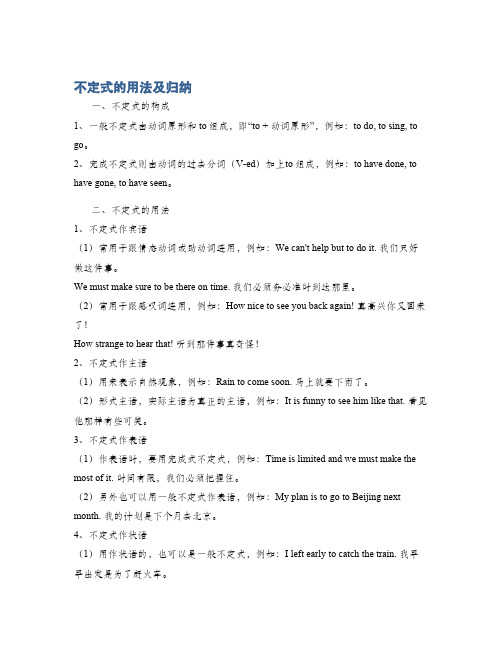
不定式的用法及归纳一、不定式的构成1、一般不定式由动词原形和to组成,即“to + 动词原形”,例如:to do, to sing, to go。
2、完成不定式则由动词的过去分词(V-ed)加上to组成,例如:to have done, to have gone, to have seen。
二、不定式的用法1、不定式作宾语(1)常用于跟情态动词或助动词连用,例如:We can't help but to do it. 我们只好做这件事。
We must make sure to be there on time. 我们必须务必准时到达那里。
(2)常用于跟感叹词连用,例如:How nice to see you back again! 真高兴你又回来了!How strange to hear that! 听到那件事真奇怪!2、不定式作主语(1)用来表示自然现象,例如:Rain to come soon. 马上就要下雨了。
(2)形式主语,实际主语为真正的主语,例如:It is funny to see him like that. 看见他那样有些可笑。
3、不定式作表语(1)作表语时,要用完成式不定式,例如:Time is limited and we must make the most of it. 时间有限,我们必须把握住。
(2)另外也可以用一般不定式作表语,例如:My plan is to go to Beijing next month. 我的计划是下个月去北京。
4、不定式作状语(1)用作状语的,也可以是一般不定式,例如:I left early to catch the train. 我早早出发是为了赶火车。
(2)另外,也有完成不定式用作状语,使句子更加丰满,例如:She looked around, having entered the room. 她走进房间后,四下张望。
动词不定式的用法总结

动词不定式的用法总结
1.作为句子的主语:
Ex: To study English is important for success.
2.作为句子的宾语:
Ex: I want to learn how to play the guitar.
3.作为动词的宾语补语:
Ex: She found it difficult to understand the instructions.
4.与一些动词连用,构成特定的动词短语:
Ex: I need to go to the store.
He wants to buy a car.
5.作为目的状语,表示动作的目的或意图:
Ex: He went to the library to study.
6.作为结果状语,表示结果或后果:
Ex: She studied hard to pass the exam.
7.作为方式状语,表示动作的方式或方法:
Ex: He walked slowly to avoid falling.
8.与形容词连用,表示主语的特征或状态:
Ex: She is happy to see her friends.
9.与副词连用,表示副词的程度或程度的变化:
Ex: He tried to be more careful.。
动词不定式的用法大全

动词不定式的用法大全今日一起学习动词不定式的用法大全?快来一起学习吧。
下面我就和大家共享,来观赏一下吧。
动词不定式的用法大全一、动词不定式是什么?简洁来说:to do,非谓语动词形式之一二、位置?须位于被其修饰的名词或代词之后如:Is this the best way to help him?三、作用?具出名词,形容词,和副词的作用四、在句中可做的成分?除了不行做谓语外,其他成分都可以充当如:主语,宾语,定语,表语,宾补,状语(目的,结果,缘由)例句:1.To see is tobelieve.眼见为实/百闻不如一见。
(做主语)2. I wish to be sentto work in the country. (做宾语)3. Can you tell me which is the car to be repaired (做定语)4. My work is to clean the room every day. (做表语)5. He went to the hospital to be examined . (做目的状语)6. I don’t think it rightto do it that way. (做宾补)留意:英语中为了避开头重脚轻(说白了就是平衡句子结构的需要),往往to do一般用it作形式主语(It+be+形容词/名词词组+to do sth/ that)如:To help each other is good. =It is good to help each other .这句话的主语是老师标紫色的字体。
五、不定式的用法1.不定式常可用来修饰人也可以修饰物,表示已经将要发生的动作。
如:(1)He was the first guest to arrive. 他是第一个到达的客人。
(2)He was a brave man to do what he did.他是个勇者才有这样的行为。
动词不定式用法大全
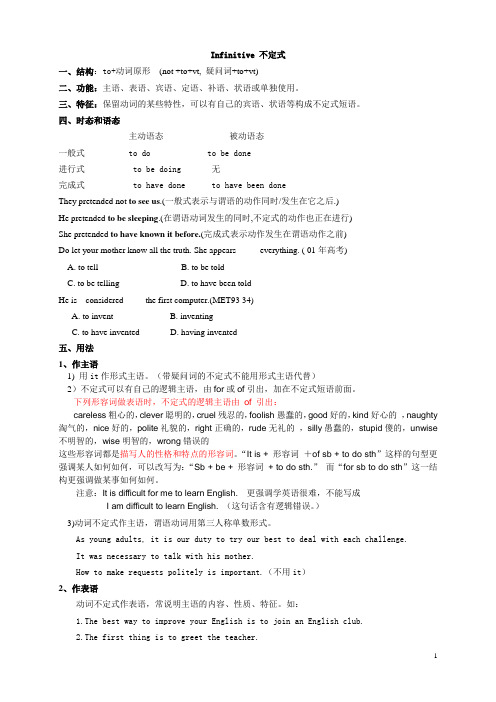
Infinitive 不定式一、结构:to+动词原形(not +to+vt, 疑问词+to+vt)二、功能:主语、表语、宾语、定语、补语、状语或单独使用。
三、特征:保留动词的某些特性,可以有自己的宾语、状语等构成不定式短语。
四、时态和语态主动语态被动语态一般式 to do to be done进行式 to be doing 无完成式 to have done to have been doneThey pretended not to see us.(一般式表示与谓语的动作同时/发生在它之后.)He pretended to be sleeping.(在谓语动词发生的同时,不定式的动作也正在进行)She pretended to have known it before.(完成式表示动作发生在谓语动作之前)Do let your mother know all the truth. She appears_____ everything. ( 01年高考)A. to tellB. to be toldC. to be tellingD. to have been toldHe is considered ____ the first computer.(MET93 34)A. to inventB. inventingC. to have inventedD. having invented五、用法1、作主语1) 用it作形式主语。
(带疑问词的不定式不能用形式主语代替)2)不定式可以有自己的逻辑主语,由for或of引出,加在不定式短语前面。
下列形容词做表语时,不定式的逻辑主语由of 引出:careless粗心的,clever聪明的,cruel残忍的,foolish愚蠢的,good好的,kind好心的,naughty 淘气的,nice好的,polite礼貌的,right正确的,rude无礼的,silly愚蠢的,stupid傻的,unwise 不明智的,wise明智的,wrong错误的这些形容词都是描写人的性格和特点的形容词。
高中英语知识点归纳动词不定式的用法和结构

高中英语知识点归纳动词不定式的用法和结构动词不定式是英语中的一种非谓语动词形式,由动词原形加上to构成。
它可以充当名词、形容词或副词,具有时态、语态和语气的特点。
在高中英语学习中,动词不定式的用法和结构非常重要。
本文将对其进行归纳总结。
一、动词不定式作主语动词不定式可以充当句子的主语,常见的结构有:1. It + be + 形容词 + 不定式作主语例如:- It is important to learn a foreign language.学习一门外语很重要。
- It is necessary to finish the task before deadline.在截止日期之前完成任务是必要的。
2. 不定式结构作主语例如:- To travel around the world is my dream.环游世界是我的梦想。
- To study hard is the key to success.努力学习是成功的关键。
二、动词不定式作宾语动词不定式可以作及物动词的宾语,常见的结构有:1. 动词 + 不定式作宾语例如:- I want to go shopping this weekend.这个周末我想去购物。
- She decided to take a break and relax.她决定休息一下,放松一下。
2. 常见的动词有:agree, hope, promise, refuse, plan, learn, wish等。
三、动词不定式作补语动词不定式可以作宾语补足语,常见的结构有:1. 动词 + 宾语 + 不定式作补足语例如:- They made him work overtime.他们让他加班工作。
- We find it interesting to solve puzzles.我们发现解谜很有趣。
2. 情态动词 + 动词原形作补足语例如:- He can't afford to buy a new car.他买不起新车。
(完整版)动词不定式用法
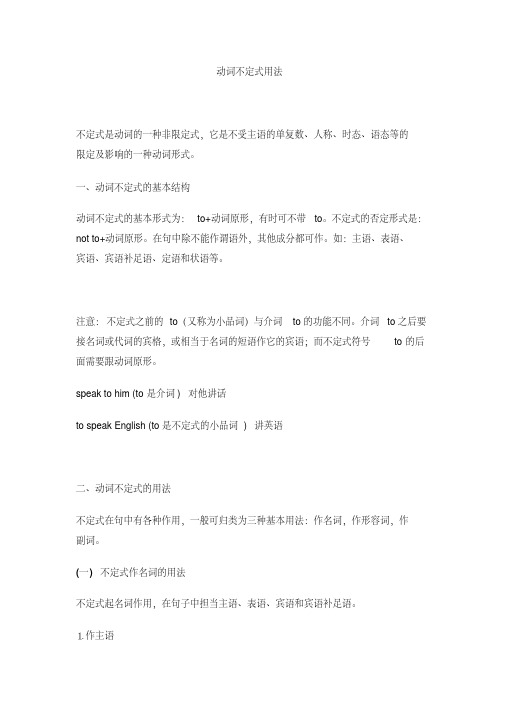
动词不定式用法不定式是动词的一种非限定式,它是不受主语的单复数、人称、时态、语态等的限定及影响的一种动词形式。
一、动词不定式的基本结构动词不定式的基本形式为:to+动词原形,有时可不带to。
不定式的否定形式是:not to+动词原形。
在句中除不能作谓语外,其他成分都可作。
如:主语、表语、宾语、宾语补足语、定语和状语等。
注意:不定式之前的to(又称为小品词)与介词to的功能不同。
介词to之后要接名词或代词的宾格,或相当于名词的短语作它的宾语;而不定式符号to的后面需要跟动词原形。
speak to him (to 是介词) 对他讲话to speak English (to 是不定式的小品词) 讲英语二、动词不定式的用法不定式在句中有各种作用,一般可归类为三种基本用法:作名词,作形容词,作副词。
(一) 不定式作名词的用法不定式起名词作用,在句子中担当主语、表语、宾语和宾语补足语。
⒈作主语名词用法的不定式和名词一样,可担任句子的主语。
To grow more trees here is very important.(=It is very important to grow more trees here.) 在这里多种些树是非常重要的。
To hear your voice is so nice.(=It is so nice to hear your voice.) 听到你的声音真高兴。
To speak English well is not easy for me.(=It is not easy for me to speak English.) 把英语说好对我来说并不容易。
To walk to school takes me twenty minutes.(=It takes me twenty minutes to walk to school.) 步行到学校我要花20分钟。
的句型中,it是形式主语,真正的主语是不定式;使用这种注意:在It is… to…”结构,可以避免句子的头重脚轻。
动词不定式的用法及归纳

动词不定式的用法及归纳英语动词不定式是一种非谓语动词形式,由"to"加上动词原形构成。
它可以用作动词、名词或形容词的补语,具有多种用法和功能。
下面是对英语动词不定式用法的归纳:1. 作为动词的补语:a. 表示目的:例如,“I study hard to pass the exam.”(我努力学习以通过考试。
)b. 表示结果:例如,“He worked hard to win the game.”(他努力工作以赢得比赛。
)c. 表示原因:例如,“I went to the store to buy some groceries.”(我去商店买一些食品杂货。
)2. 作为名词的补语:a. 作主语:例如,“To travel is my dream.”(旅行是我的梦想。
)b. 作宾语:例如,“She likes to dance.”(她喜欢跳舞。
)3. 作为形容词的补语:a. 表示目的或结果:例如,“This is a book to read for pleasure.”(这是一本供娱乐阅读的书。
)b. 表示能力或目标:例如,“He is a person to trust.”(他是一个值得信任的人。
)4. 不定式的时态与语态变化:a. 时态变化:不定式不具有时态,但可以通过上下文来暗示时间关系。
b. 语态变化:不定式可以通过添加"be"动词的相应形式来表示被动语态。
例如,“He wants to be invited to the party.”(他希望被邀请参加派对。
)总之,不定式在句子中扮演着多种角色,并且具有多种用法和功能,具体使用取决于上下文和意图。
最全面英语动词不定式的用法归纳整理总结
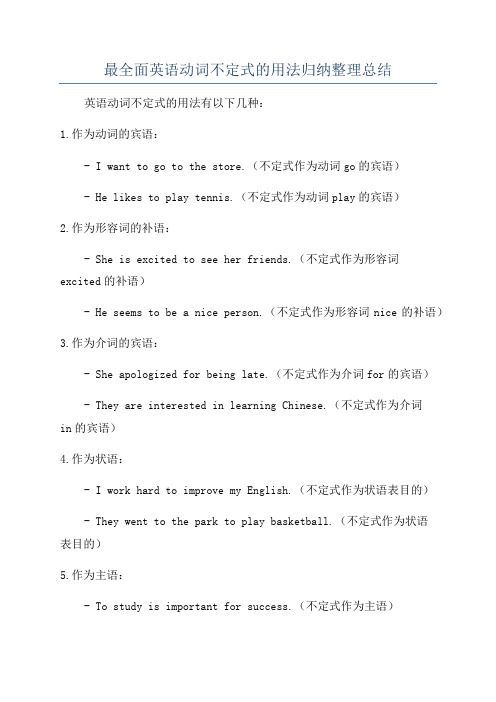
最全面英语动词不定式的用法归纳整理总结英语动词不定式的用法有以下几种:1.作为动词的宾语:- I want to go to the store.(不定式作为动词go的宾语)- He likes to play tennis.(不定式作为动词play的宾语)2.作为形容词的补语:- She is excited to see her friends.(不定式作为形容词excited的补语)- He seems to be a nice person.(不定式作为形容词nice的补语)3.作为介词的宾语:- She apologized for being late.(不定式作为介词for的宾语)- They are interested in learning Chinese.(不定式作为介词in的宾语)4.作为状语:- I work hard to improve my English.(不定式作为状语表目的)- They went to the park to play basketball.(不定式作为状语表目的)5.作为主语:- To study is important for success.(不定式作为主语)- To be or not to be, that is the question.(不定式作为主语)6.作为条件状语从句的口述形式:7.作为动词的补语:- They considered him to be the best candidate.(不定式作为动词consider的补语)- We elected her to be the team captain.(不定式作为动词elect的补语)8.作为状语从句的口述形式:- He woke up early in order to catch the train.(不定式作为状语从句的口述形式)9.作为表语:需要注意的是,不定式的肯定形式一般由to加动词原形构成,否定形式则在to后面加not构成。
不定式用法归纳
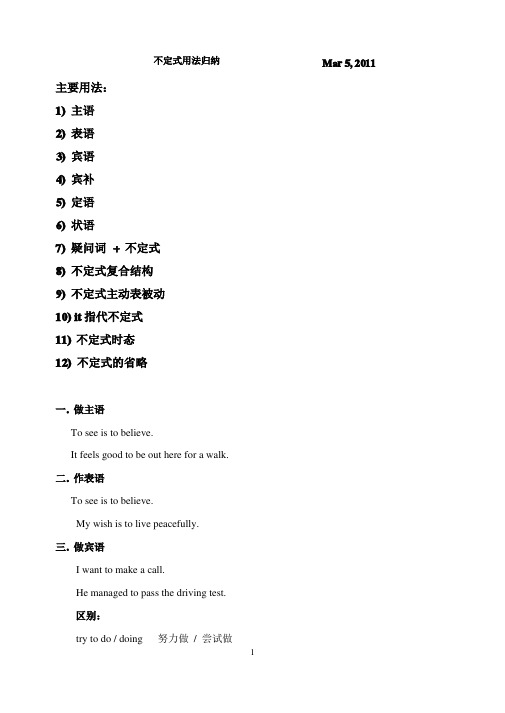
不定式用法归纳Mar 5, 2011主要用法:1)主语2)表语3)宾语4)宾补5)定语6)状语7)疑问词+不定式8)不定式复合结构9)不定式主动表被动10) it指代不定式11)不定式时态12)不定式的省略一.做主语To see is to believe.It feels good to be out here for a walk.二.作表语To see is to believe.My wish is to live peacefully.三.做宾语I want to make a call.He managed to pass the driving test.区别:try to do / doing努力做/尝试做stop to do / doing停下一件事去做另一件事/停下正在做的事remember (forget, regret) to do / doing没有做用to do;做过了用doingmean to do / doing打算做/意味着go on to do / doing接着做另一件事/继续做同一件事四.做宾补感官动词/使役动词+宾语+do(这里免to的不定式作宾补)常用的感官动词:see, hear, feel常用的使役动词:have, letThey knew her very well. They had seen her grow up from childhood.As you’ve never been here before, I’ll have someone show you the way. (90上海)The mother felt herself grow cold and her hands trembled as she read the letter from the battlefield. (2006上海)五.作定语用法1:不定式和被修饰词之间有动宾关系。
高中英语知识点归纳不定式的用法
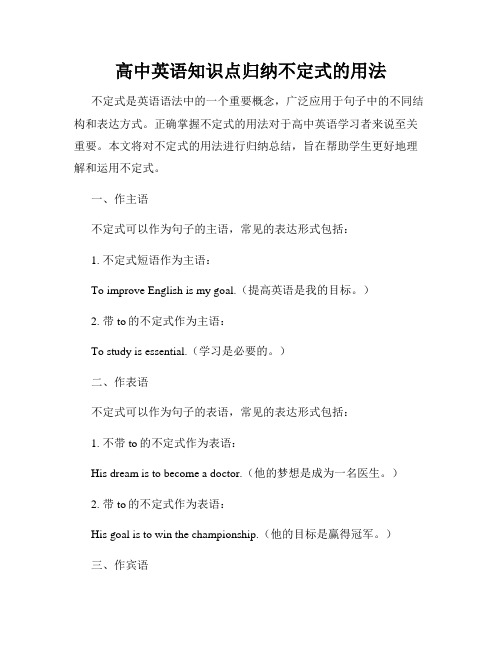
高中英语知识点归纳不定式的用法不定式是英语语法中的一个重要概念,广泛应用于句子中的不同结构和表达方式。
正确掌握不定式的用法对于高中英语学习者来说至关重要。
本文将对不定式的用法进行归纳总结,旨在帮助学生更好地理解和运用不定式。
一、作主语不定式可以作为句子的主语,常见的表达形式包括:1. 不定式短语作为主语:To improve English is my goal.(提高英语是我的目标。
)2. 带to的不定式作为主语:To study is essential.(学习是必要的。
)二、作表语不定式可以作为句子的表语,常见的表达形式包括:1. 不带to的不定式作为表语:His dream is to become a doctor.(他的梦想是成为一名医生。
)2. 带to的不定式作为表语:His goal is to win the championship.(他的目标是赢得冠军。
)三、作宾语不定式可以作为句子的宾语,常见的表达形式包括:1. 动词不定式作宾语:I want to go to the park.(我想去公园。
)2. 动词短语加不定式作宾语:He decided to take a break and relax.(他决定休息放松一下。
)四、作定语不定式可以作为句子的定语,常见的表达形式包括:1. 修饰名词的不定式:I have a book to read.(我有一本书要读。
)2. 修饰代词的不定式:He has something to say.(他有话要说。
)五、作状语不定式可以作为句子的状语,常见的表达形式包括:1. 表示目的或原因的不定式:He went to the supermarket to buy some groceries.(他去超市买了一些食品杂货。
)2. 表示结果的不定式:He spoke so loudly as to wake up the whole neighborhood.(他说得很大声,把整个邻居都吵醒了。
不定式用法归纳全

总之: 能带不定式作宾语或宾补的动词,只是一些固定的动词(再把以上两页复习)。 因为其他动词的意思不一样,虽有时形式是一样,但分析句子成分是,就不一样了,常是 动+宾.+to do/doing作定语;或动词+to do作目的/结果状语。 技巧:即把特殊的几个动词记住即可,有时若觉分析句子成分很难,但知道怎么用即可。
(以上两句是there be 结构,to do/to be done是前面名词的定语) There is no need to tell him.
It is no use to do.这个句子中,to do不能做定语,所以是真正主语,it 是 形式主语,不能用there 替换)
你现在学习的是第11页,课件共23页
• (2)如果系动词后的动词说明主语的性质,特征,相当于形容词。这时
就要用现在分词作表语,而不用不定式。 例如: He said that the story was interesting.他说这则故事很有趣 Nurse’s responsibility is taking care of patients.
(1)动词不定式往往放在系动词be(,become, sound, taste 等系动词 后面一般不接不定式)的后面作表语,表示将来的情况,说明主语的
内容。
例如: My wish is to become a teacher.我的愿望是当一名教师。 Your job today is to clean the playground. 你今天的工作是打扫操场。
• 四、作状语
• ⑴动词不定式作状语可表示目的、原因及结果等,例如:
Come to see me again soon. (表目的)。
动词不定式用法大全

动词不定式用法大全
1. 作为动词的宾语:I want to go (我想去)。
2. 作为动词的补语:He seems to know the answer (他似乎知道答案)。
3. 作为目的状语:He went to the store to buy some groceries (他去商店买些杂货)。
4. 作为原因状语:I stayed home to finish my homework (我呆在家里完成我的家庭作业)。
5. 作为结果状语:He ran fast to catch the bus (他跑得快以赶上公共汽车)。
6. 用于被动语态:I hope to be invited to the party (我希望被邀请参加晚会)。
7. 用于虚拟语气:If I were you, I would study harder (如果我是你,我会更加努力学习)。
8. 用于感叹句:What a wonderful place to visit! (真是一个美妙的地方可供参观)
此外,动词不定式还可以有时态和语态的变化,如:to be + 动词的不定式形式。
在句子中,动词不定式通常是以 "to" 作为引导词,但有时也可以省略 "to",具体取决于动词或动词短语的前后关系。
需要注意的是,动词不定式一般不具有时态和人称的变化,常用的形式为:to + 动词原形。
总之,动词不定式在句子中具有多种用法,可以根据句子的结构和意义来确定具体的用法。
- 1、下载文档前请自行甄别文档内容的完整性,平台不提供额外的编辑、内容补充、找答案等附加服务。
- 2、"仅部分预览"的文档,不可在线预览部分如存在完整性等问题,可反馈申请退款(可完整预览的文档不适用该条件!)。
- 3、如文档侵犯您的权益,请联系客服反馈,我们会尽快为您处理(人工客服工作时间:9:00-18:30)。
• To do,do根据语境有各种时态和语态,时态就要与不定式前面的动 词对比了,是在之前?后?还是正在或同时 如,to do/to be done/ to have been done等(后面会具体讲)
• 再如: It is an easy sentence to translate. 这个句子很容易翻译。
(3) There +be +n. +to do/ be done 用主动式作定语, 重点在人, 用被动式作定语, 重点在物。
例如: 没有时间可以耽误。可译成:
• A,There is no time to lose( to lose之前可加for sb(us) to lose,强调人);
• (二)、在某些“形容词+不定式”的结构中, 不定式要 用主动形式表被动。
• 其句型有: • 1)n. +be+adj. +to do
The question was very difficult to answer. 这问题很难回 答。 • The job is very easy to do. 这工作很容易做。
• we think it important to obey the laws. √ • we think to obey the laws important. ×
(3)不定式作介词宾语 • 当介词but、except、besides前面有行为动词do及其各种形式
时,介词后面的不定式可以省略to,否则不省略。 What do(助动词不算) you like to do besides play football? We have no choice but to wait. The boy has him own idea of how to finish it.
It is no use to do.这个句子中,to do不能做定语,所以是真正主语, it 是形式主语,不能用there 替换)
• 四、作状语 • ⑴动词不定式作状语可表示目的、原因及结果等,例如:
Come to see me again soon. (表目的)。 You couldn‘t do that to save your life. (表目的)
因为其他动词的意思不一样,虽有时形式是一样,但分析句子成分是,就不一样 了,常是动+宾.+to do/doing作定语;或动词+to do作目的/结果状语。 技巧:即把特殊的几个动词记住即可,有时若觉分析句子成分很难,但知道怎么
四、作定语
(1)不定式作定语用来修饰名词或代词,置于它所修饰的名词后; 若该名词还有其他后置定语,不定式就放在其他后置定语的后(如下例子)。 同时与它所修饰的名词或代词形成逻辑上的主动或被动关系。
• (1)I have some work to do
•
I have a letter to be typed.
to do是前面一个名词(常是人)发出的动作;
to be done不是前面名词(人) 发出的动作,是句子外的 其他人发出的动作。
• 试比较:
Have you anything to do this afternoon? 今天下午你有事要做吗?(to do是由you发出的)
如,
• He always has a lot of meetings to attend. 不定式to attend 和名词meetings 是主动表被动,表示attend这个 词是句子主语he发出的,若用to be done,表动作是除主语外的其 他人发出的。如,I have a letter to be typed.
• 五、作表语 • (一)
(1)动词不定式往往放在系动词be(,become, sound, taste 等 系动词后面一般不接不定式)的后面作表语,表示将来的情况, 说明主语的内容。 例如: My wish is to become a teacher.我的愿望是当一名教师。 Your job today is to clean the playground. 你今天的工作是打扫操场。
二、作宾语
• (1)能够接动词不定式作宾语的有(固定结构)
• agree to do determine to do
beg to do(请求做…) decide to do
fail to do
hope to do
manage to do(通过努力成功过了…)
offer to do
• plan to do
(2)如果作定语用的不定式是不及物动词,就要加上介 词,使被修饰的这个词成为这个介词的逻辑宾语。
• He is looking for a room to live in. • Please pass me some paper to write on. • (对比下上一页的)
(3)上述不定式后加介词时,不能省略介词, 但当修饰place,time,way时,介词可以省略。
不定式的构成及意义
• 动词不定式是由“to+动词原形”构成 (有时可以不带to)。
• 其否定形式是“not+动词不定式”.
• 它是非谓语动词的形式的一种,在句子中不能充当谓语,可作主语、 宾语、补足语、表语、定语及状语等成分。
• 但它可以保留动词的性质,其本身可以带宾语或状语等附加成分(不 定式和其附加成分称为不定式短语)。
•
to be lost. (强调物)(谁 lost time不明确)。
• B ,There is nothing to do now. (=We have nothing to do now. ) 现在没事干(强调人)。
There is nothing to be done. (=We can do nothing now. ) 现在没办法了(强调物)。
• (2) only to do sth. only doing sth. 都可作表示结果的状语,
区别: only to do sth. 表示一个与主语愿望相反的或出乎主语意料的 结果, only doing sth. 表示谓语动词本身的动作造成的结果(没有出乎 预料的意思)。 例如:
I worked hard, only to fail at last. 我努力工作,结果最后却是失败(出乎预料)。 He died, only leaving nothing but debts. 他死了,只留下一身债(无出乎意料之义)
一、作主语
• (1)动词不定式作主语时,谓语动词用单数。 To do morning exercises is useful for our health. 做早操有利于我们的健康。
• (2)如果动词不定式太长,常常用 it 作形式主语, 而将真正的主语——动词不定式后置。
It took me half an hour to walk there.
• She enjoys reading very much.她非常喜欢读书。
• The driver failed to see the other car in time. 司机没能及时看见另一辆车。
(2)动词不定式做宾语,可此宾语后还有宾语补足语的,通常要 用 it 作形式宾语,而将真正的宾语——动词不定式后置。(前 页中无宾补)例如:
• The next train to arrive was from Seattle. (To arrive 和train是主动关系,都不存在需用被动了 ).
• Do you have anything interesting to read? (to read与anything是主动表被动,因为是句子主语you发出的; 且放在anything的后置定语之一“interesting”之后).
time(宾补). (去掉不定式,句义不完整)
(区别以下例子) consider doing (只有宾语) expect to do (只有宾语)
want t语)
区别 I go to see my teacher(目的状语).
总之: 能带不定式作宾语或宾补的动词,只是一些固定的动词(再把以上两页复习)。
三、作宾语补足语 (注:不是做宾语哟)
(1)能带宾语补足语动词有,
(一感) feel sb do/doing
(二听) listen to sb do/doing hear sb do/doing
(三让) let sb do/doing
make sb do/doing
have sb do/doing
prepare to do
pretend(假装) to do,
promise to do
refuse to do
wish to do
• would like/love to do
• 但 finish, enjoy, miss, appreciate, mind, advise, suggest 等 动词后面通常只能接动名词作宾语。例如:
(四看) look at,see,watch,notice
不带to的不定式作宾语补足语,强调动作的完成过程.
(变成被动时,to要补上,
如:
I heard her sing today=She was heard to sing today.(强调整个 过程)
• I heard her singing at that time.(我听到她正在唱歌)
(2)(不定式前有性质形容词:难易(easy、 difficult),轻重(light,heavy)、兴趣(interesting)、 可能(possible)、安危(safe,dangerous)
